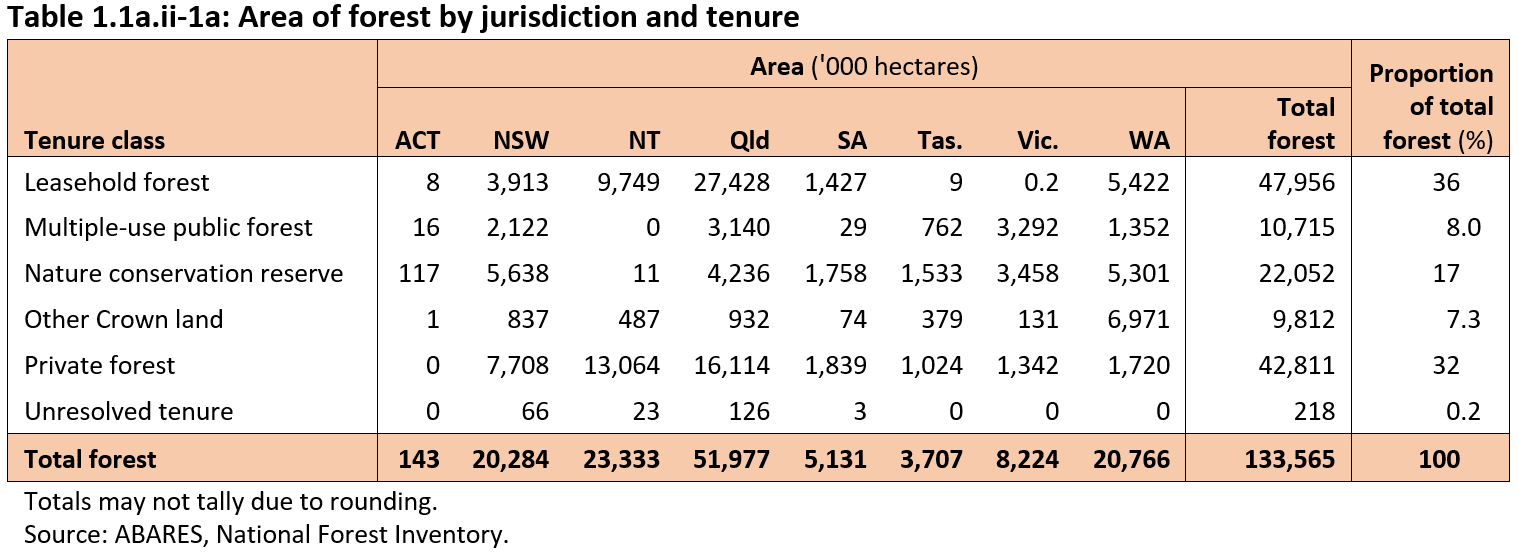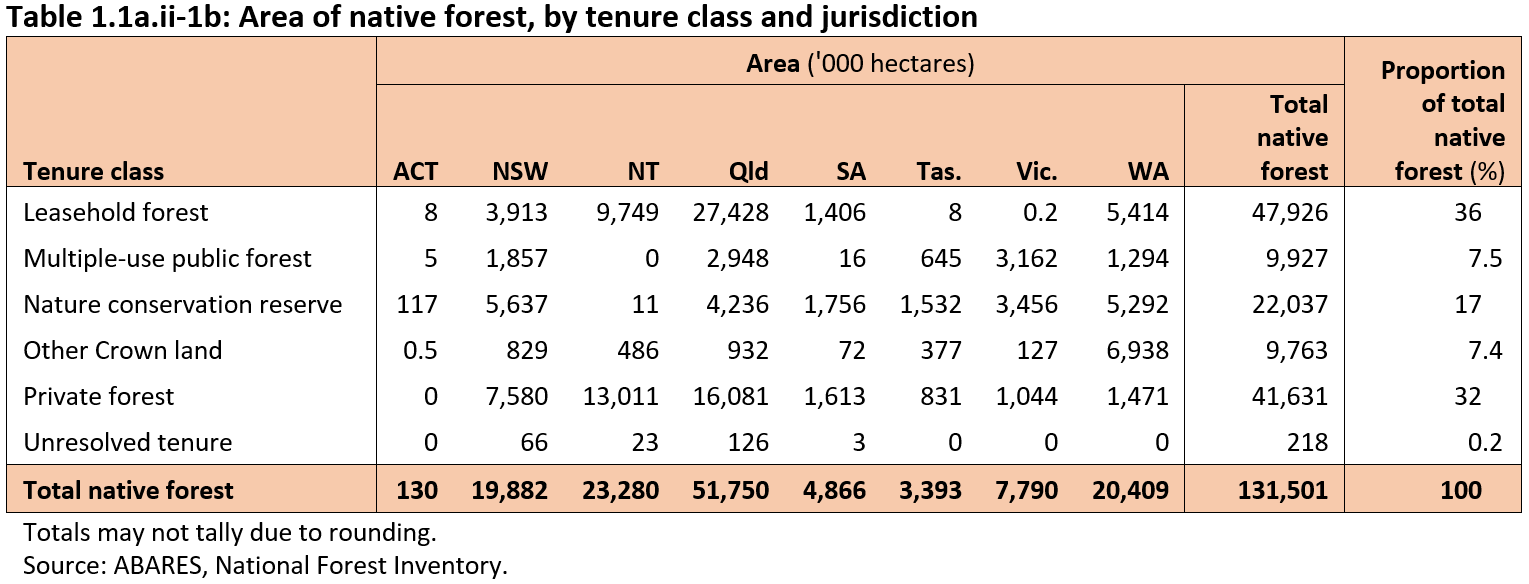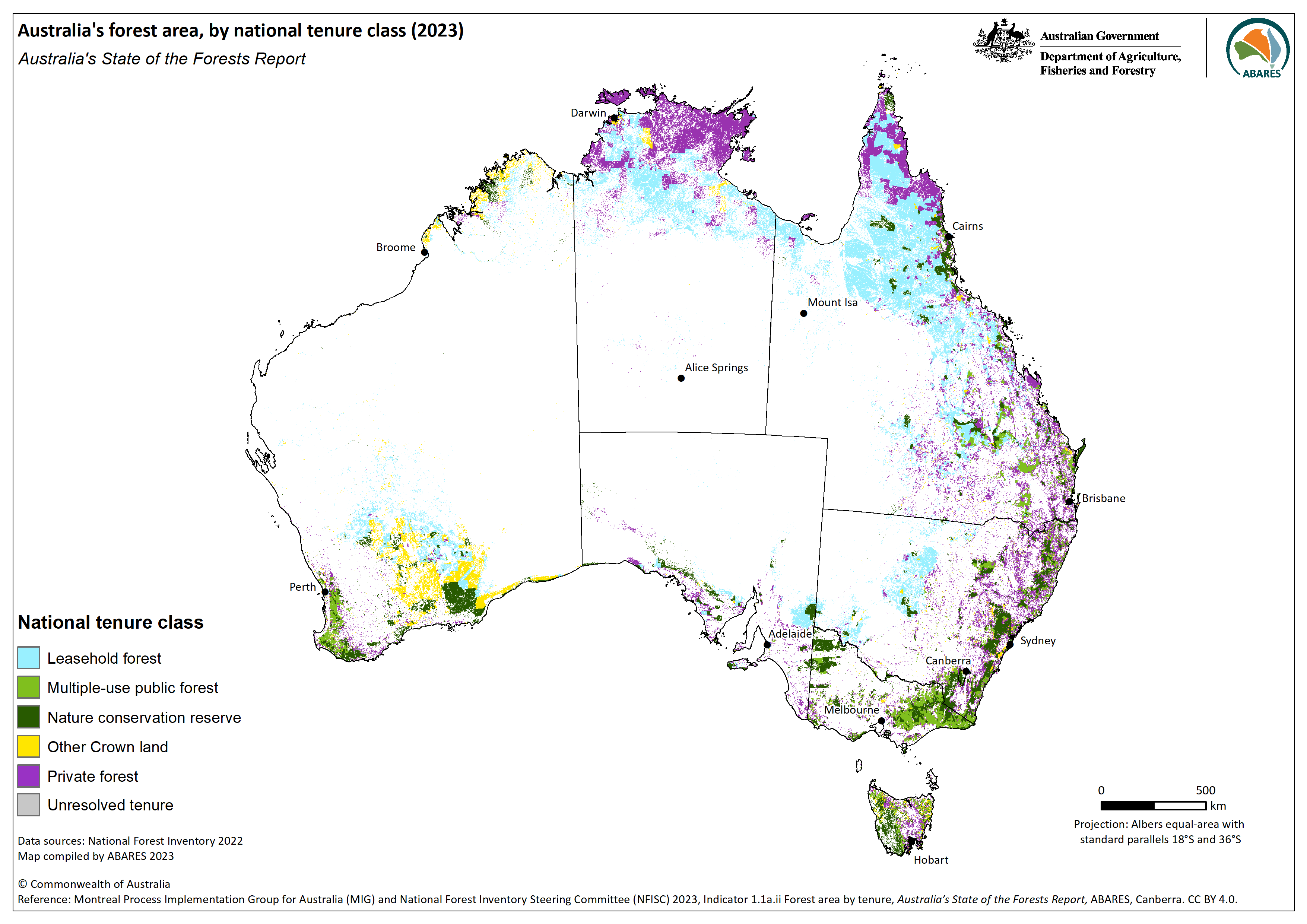This indicator (Indicator 1.1a) uses the area for each forest type over time as a broad measure of the extent to which forest ecosystems and their diversity are being maintained. Reporting on forest tenure aids our understanding of how different land management regimes may impact on forest biodiversity.
This part of Indicator 1.1a Area of forest by forest type and tenure, published December 2023, presents the area of Australia’s forests by tenure.
- The majority of Australia’s 133.6 million hectares of forest is privately managed under private and leasehold land (90.8 million hectares, 68% of total native forest).
- 22.1 million hectares (17%) of Australia’s forest is on formal nature conservation reserves.
- 10.7 million hectares (8.0%) of Australia’s forest is on multiple-use public native forest tenure.
- 10.0 million hectares (7.6%) of Australia’s forest is on other Crown land or where tenure is unresolved.
Land tenure is the formal land title system that declares the legal relationship between people and land. Tenure describes who owns which land, and determines who has the right to use and occupy land and the activities that are permitted on that land. For forests, land tenure is a key attribute that has a major bearing on how forests can be managed, and underpins the identification of who has access to, and rights of use over, forests and forest resources. Tenure of forest land cannot always be used to determine ownership of trees.
In the National Forest Inventory, forest tenure is reported in six national tenure classes that bring together the range of tenures used by each state and territory across Australia:
- Leasehold forest – Crown land held under leasehold title and generally privately managed although state and territory governments may retain various rights over the land, including over forests or timber on the land. This class includes land held under leasehold title with special conditions attached for designated Indigenous communities.
- Multiple-use public forest – Publicly owned state forest, timber reserves and other land on which a range of forest values are managed by state and territory government agencies in accordance with relevant Acts and regulations. The forest values can include provision of wood for harvest, supply of water, conservation of biodiversity, recreation, and environmental protection.
- Nature conservation reserve – Crown land that is formally reserved for environmental, conservation and recreational purposes, including national parks, nature reserves, state and territory recreation and conservation areas, and some formal reserves in state forests as defined by jurisdictions. It does not include informal reserves and those pending gazettal. The commercial harvesting of wood and non-wood forest products is generally not permitted in nature conservation reserves.
- Other Crown land – Crown land reserved for a variety of purposes, including utilities, scientific research, education, stock routes, mining, water-supply catchments, and use by Indigenous communities. Includes Crown land that is unreserved or unallocated. Excludes leasehold forest, nature conservation reserve, and multiple-use public forest.
- Private forest – Land held under freehold title and typically under private ownership. It excludes leased Crown land, but includes land held under freehold title with special conditions attached for designated Indigenous communities.
- Unresolved tenure – Land where data are insufficient to determine land ownership status.
The process for assembling and reporting the tenure of Australia’s forest is summarised in the Supporting information for Indicator 1.1a.ii – Forest area by tenure and in Jacobsen et al. (2019). The process accepts state and territory datasets as the authoritative source of tenure data, where they are available. The most recent spatial compilation for this indicator, Tenure of Australia’s forests (2023), supplements these state and territory datasets with national land tenure information from PSMA Australia Limited and previous NFI national tenure compilations.
Changes over time in the area of forest in different tenure classes reflect both changes in the total area of forest and changes in tenure classification of some areas of forest (see Supporting information for Indicator 1.1a.ii – Forest area by tenure).
Private and Leasehold forests account for 90.8 million hectares of Australia forests (68% of Australia’s total forest area) (Table 1.1a.ii-1a). Queensland contains the largest area of Leasehold forest, with 27.4 million hectares, and Private forest with 16.1 million hectares (Figure 1.1a.ii-1).
Forest on Nature conservation reserve tenure accounts for 22 million hectares of forest (17%), most of which is native forest (Table 1.1a.ii-1b). Large areas of these are found in New South Wales, Western Australia and Queensland (Figure 1.1a.ii-1).
Click here for a Microsoft Excel workbook of the data for Table 1.1a.ii-1a.
Click here for a Microsoft Excel workbook of the data for Table 1.1a.ii-1b.
Private and Leasehold forest contain the largest area of Australia’s forests, totaling 90.8 million hectares (Table 1.1a.ii 1a). The largest areas of these are in the Northern Territory and Queensland (Figure 1.1a.ii-1).
Of Australia’s total forest area of 134 million hectares, 48.0 million hectares (36%) is on Leasehold tenure and 42.8 million hectares (32%) is on Private tenure. This combined 90.8 million hectares is privately managed forest and covers 68% of the total area of Australia’s forest. Freehold land held by Indigenous communities is included in the national land tenure class of Private forest.
Of the total area of 132 million hectares of native forest (Table 1.1a.ii-1b), 47.9 million hectares (36% of the total area of Australia’s native forest) is on Leasehold tenure and 41.6 million (32%) hectares is on Private tenure. Together, a total of 89.6 million hectares (68%) of native forest are privately managed. Some of these forests are privately managed for wood production.
The jurisdictions with the highest proportion of their native forest that is privately managed are the Northern Territory (96% of native forest area) and Queensland (84% of native forest area). In Queensland, under the Forestry Act 1959 the state retains rights of ownership and access to timber and associated forest products of commercial value on all Crown land, including land leased to a private lessee under the Land Act 1994.
The jurisdictions with the lowest proportions of their native forest that is privately managed are Victoria (13% of native forest area) and the Australian Capital Territory (6% of native forest area).
Forest on Nature conservation reserve tenure total 22.1 million hectares of Australia’s total forest area of 134 million hectares (17% of total forest area) (Table 1.1a.ii-1a). Effectively all of this is native forest (Table 1.1a.ii-1b).
By jurisdiction, the largest area of native forest on Nature conservation reserve tenure is in New South Wales with 5.6 million hectares (26% of the total native forest on Nature conservation reserve tenure) and Western Australia with 5.3 million hectares (24%).
The Australian Capital Territory has the highest proportion of its total native forest area on Nature conservation reserve tenure (90%), followed by Tasmania (45%), Victoria (44%) and South Australia (36%) (Table 1.1a.ii-1a).
Nature conservation reserves have a range of legislated management intents including the protection of biodiversity. Some forest areas in other land tenure classes also have their legislated management intent as protection of biodiversity, including Indigenous-owned or Indigenous-managed land on private, leasehold or other Crown land. Further information and data can be found in:
- forest in protected area categories (Indicator 1.1c)
- Indigenous forest estate (Indicators 6.4a and 6.4c in Criterion 6).
Forest on Multiple-use public forest tenure totals 10.7 million hectares (8.0% of Australia’s total 134 million hectares of forest) (Table 1.1a.ii-1a). These forests are predominately in the south-east and south-west of Australia (Figure 1.1a.ii-1).
- 9.9 million hectares of Multiple-use public forest is native forest (7.5% of Australia’s total native forest area) (Table 1.1a.ii-1b).
Multiple-use public native forests have multiple management objectives. In some jurisdictions, wood harvesting is permitted in multiple-use forests, but not where restricted by jurisdictional forest management codes of practice (see Indicator 2.1a).
By jurisdiction, the largest areas of multiple-use public native forests (Table 1.1a.ii-1b) occur in: Victoria, with 3.1 million hectares (32% of the total area of multiple-use public native forests); Queensland, with 2.9 million hectares (30%); and New South Wales, with 1.9 million hectares (19%).
By proportion of total native forest, Victoria (41%) and Tasmania (19%) have the highest proportions of their native forest area in Multiple-use public forests. For all other jurisdictions the proportion of their native forest area in Multiple-use public forests is less than 10%.
Forest on Other Crown land tenure and Unresolved tenure total 10.0 million hectares (7.8% of Australia’s total forest area) (Table 1.1a.ii-1a). The largest areas of Other Crown land are found in Western Australia (Figure 1.1a.ii-1).
Of Australia’s total forest area of 134 million hectares, 9.8 million hectares of forest is on Other Crown land (7.3% of Australia’s total forest area).
Western Australia has 6.9 million hectares of native forest on Other Crown land (71% of the total native forest on Other Crown land).
Other Crown land includes land owned by Commonwealth or state and territory governments that is used for a variety of purposes such as utilities, research, education, mining and water supply catchments, and is not covered by other national tenure classes. This tenure class also includes unreserved Crown land and unallocated Crown land.
An additional 0.2 million hectares of forest is on land with Unresolved tenure (0.2% of Australia’s total forest area).
Further information
Click here for Supporting information for 1.1a.ii Forest area by tenure
- Methodology for determining the tenure of Australia’s forests
- Differences in native forest areas by tenure class since SOFR 2018
Downloads
- Indicator 1.1a.ii Forest area by tenure - pdf
- Tabular data for Indicator 1.1a.ii - Microsoft Excel workbook
- Tenure of Australia's forests (2023) - spatial dataset
References
Jacobsen R, Mutendeudzi M, Howell CI, Read SM (2019). Development of a national tenure dataset for reporting the tenure of Australia’s forests, ABARES technical report, Canberra, August. CC BY 4.0. doi.org/10.25814/5d5e34e2d3dcc



